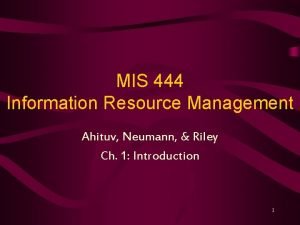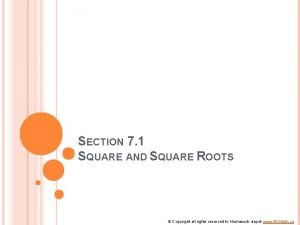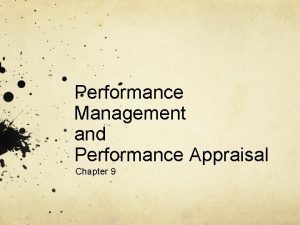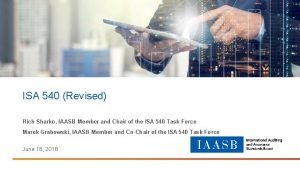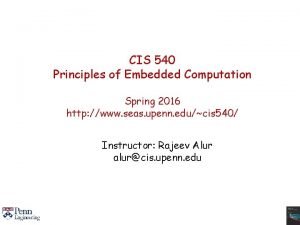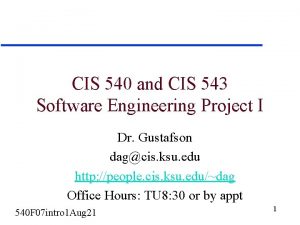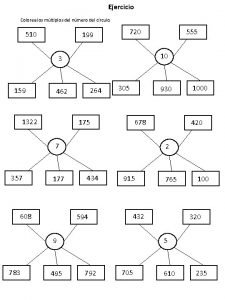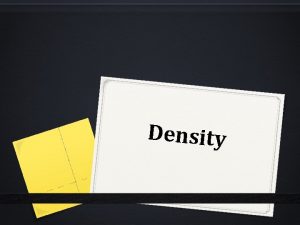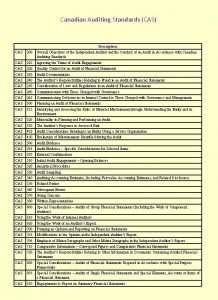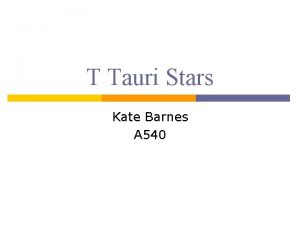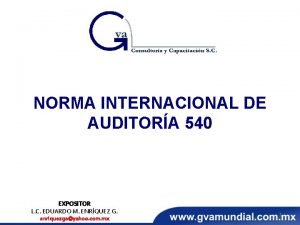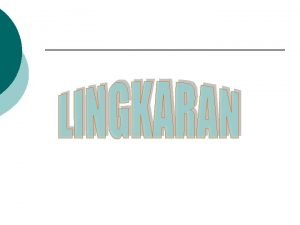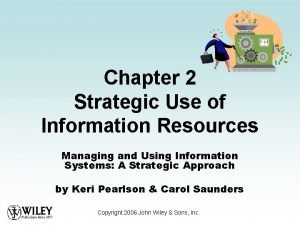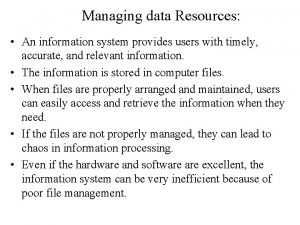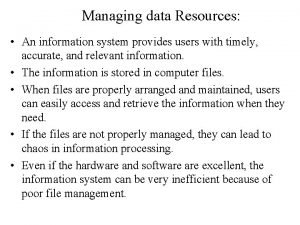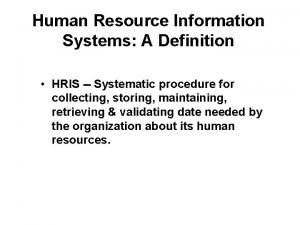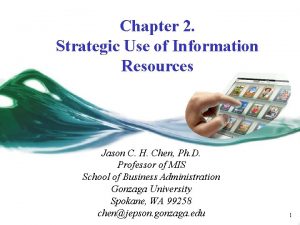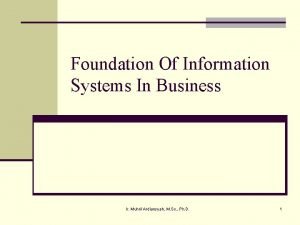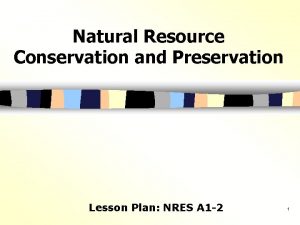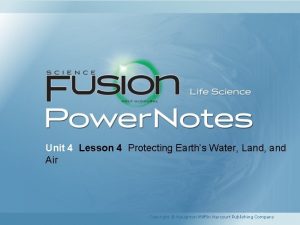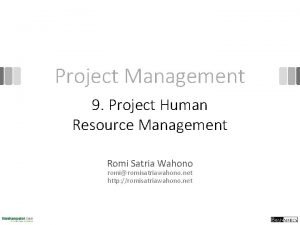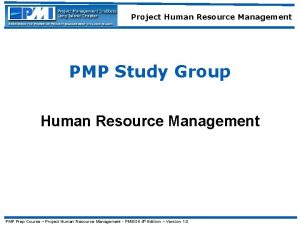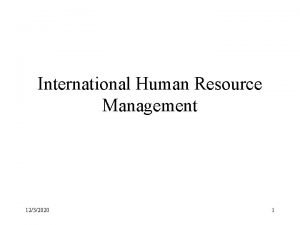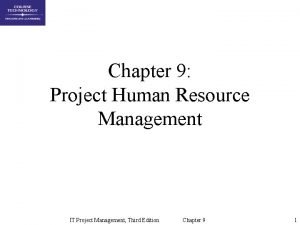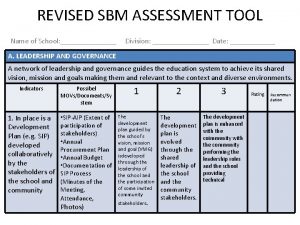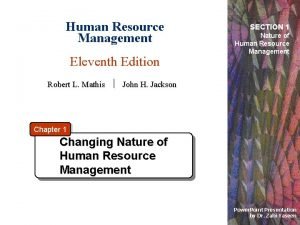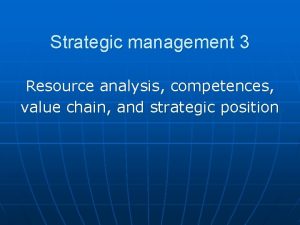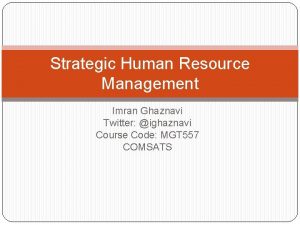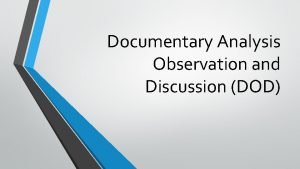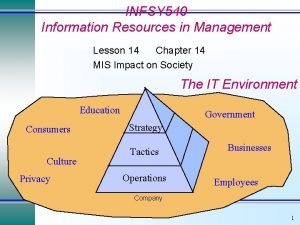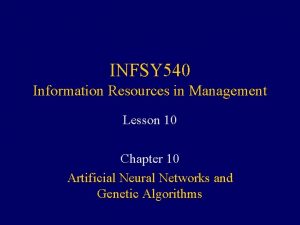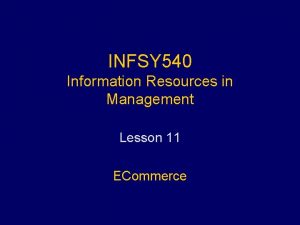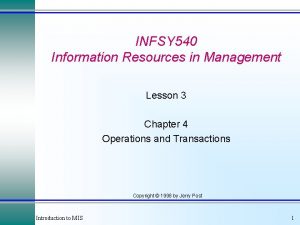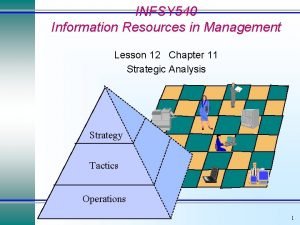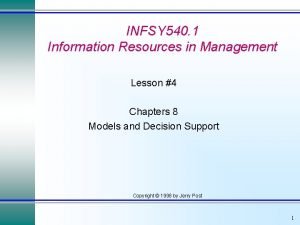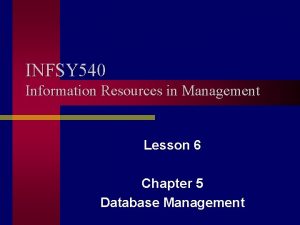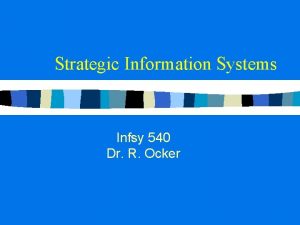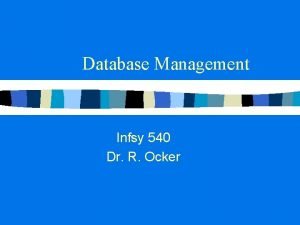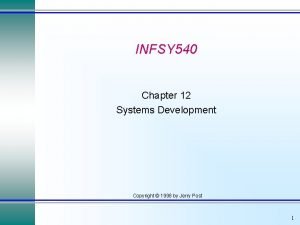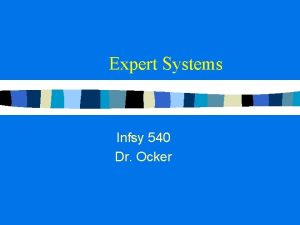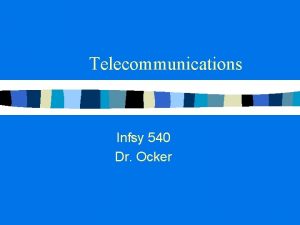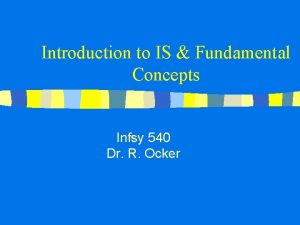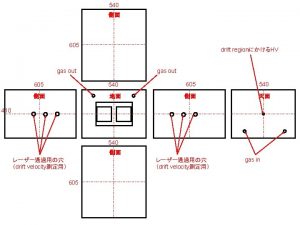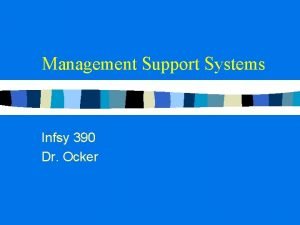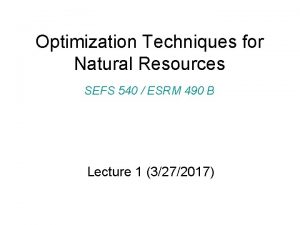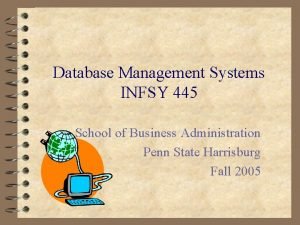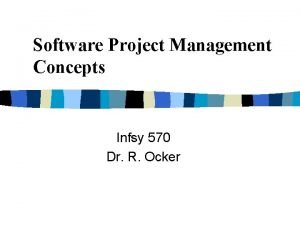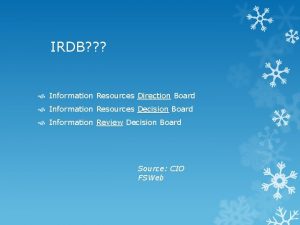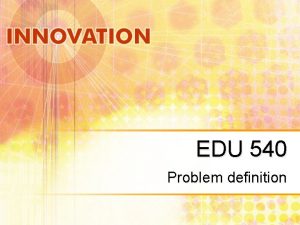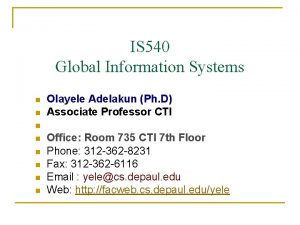INFSY 540 Information Resources in Management Lesson 9






















































- Slides: 54

INFSY 540 Information Resources in Management Lesson 9 Chapter 10 Artificial Intelligence & Expert Systems

Learning Objectives Define “artificial intelligence” (AI) Identify the major types of AI systems & provide an example of each List the characteristics and basic components of expert systems Identify at least 3 factors to consider in evaluating the development of an expert system Outline & explain the steps in developing an expert system Chapter 10 Slide 2

How do AI persons think? What is AI? What is I? Chapter 10 Slide 3

Characteristics of Intelligence Ability to Communicate Creativity Internal Knowledge Ability to Learn World Knowledge Goal-Directed Behavior Self Awareness Chapter 10 Slide 4

A Hierarchical Model of Intelligence Wisdom Knowledge Information Data Chapter 10 + Vision + Experience + Context Slide 5

What is Artificial Intelligence? Good Question. There is no generally accepted definition of Artificial Intelligence. Why? In practice, it is an “umbrella term” l It is multidisciplinary l Technologies regularly enter and exit the AI “umbrella” l Chapter 10 Slide 6

AI is a Multi-Disciplinary Field Psychology Cognitive Science Artificial Intelligence Linguistics Chapter 10 Historically, AI practitioners came from diverse backgrounds in both “hard” and “soft” sciences. Computer Science Engineering What other disciplines have been involved in AI? Slide 7

Brief History of AI 1943 Mc. Culloch & Pitts paper on neurons 1950 Age of computer simulation begins 1956 Cognitive AI & Neural Computing fields begin (Dartmouth Summer Research Conference) 1957 Rosenblatt’s Perceptron 1959 Widrow & Hoff’s MADALINE 1960’s Growth, Progress and Excessive Hype in all of AI 1969 Minsky & Papert’s critique of Perceptrons (Results in stunted growth of Neural Networks: 1969 -1984) 1986 Re-birth of Neural Networks 1997 Deep Blue defeats reigning chess grandmaster Chapter 10 Slide 8

Turing’s Test Can the human on the left tell whether the output is coming from the computer or the human on the right? Chapter 10 Slide 9

Features of Artificial Intelligence The use of computers to do symbolic reasoning A focus on problems that do not respond to algorithmic solutions Problem solving using inexact, missing, or poorly defined information An effort to capture and manipulate the significant qualitative features of a situation rather than relying on numerical methods Chapter 10 Slide 10

Features of Artificial Intelligence An attempt to deal with issues of semantic meaning as well as syntactic form Answers that are neither exact or optimal, but are in some sense “sufficient” The use of large amounts of domain-specific knowledge in solving problems The use of meta-level knowledge to effect more sophisticated control of problem-solving strategies Chapter 10 Slide 11

Application Categories Interpretation Prediction Diagnosis Design Planning Monitoring Debugging Repair Instruction Control Optimization Chapter 10 Inferring situation from observations Inferring likely consequences of situation Inferring malfunctions Configuring objects under constraints Developing plans to achieve goals Comparing observations to plans Prescribing remedies for malfunctions Executing a plan to administer a remedy Diagnosing and correcting performance Managing system behavior Finding “best” solutions to problems Slide 12

Some AI Technologies Expert Systems Neural Networks Genetic Algorithms Fuzzy Logic Robotics Natural-Language Processing Intelligent Tutorials Computer Vision Virtual Reality Game Playing Chapter 10 Slide 13

Some AI Technologies Expert Systems: Diagnose, respond & act like a human expert Neural Networks: Use data to predict outputs or interpret inputs Genetic Algorithms: Use data to find “optimal” solutions Fuzzy Logic: Facilitate solutions to human vagueness problems Robotics: Mimic physical human processes Natural-Language Processing: Mimic human communication Intelligent Tutorials: Facilitate human learning Computer Vision: Mimic human sensory(visual) process Virtual Reality: Mimic human reality inside a computer Game Playing: Beat humans in games, e. g. chess Chapter 10 Slide 14

Cognitive vs Biological AI Cognitive-based Artificial Intelligence Top Down approach l Attempts to model psychological processes l Concentrates on what the brain gets done l Biological-based Artificial Intelligence Bottom Up approach l Attempts to model biological processes l Concentrates on how the brain works l Chapter 10 Slide 15

Cognitive vs Biological AI Cognitive AI Tools: l l l l Expert Systems Natural Language Fuzzy Logic Intelligent Agents Intelligent Tutorials Planning Systems Virtual Reality Biological AI Tools l l l l Chapter 10 Neural Networks Speech Recognition Computer Vision Genetic Algorithms Evolutionary Programming Machine Learning Robotics Slide 16

What is Artificial Intelligence? Some definitions of AI: l Eugene Charniak, “. . . the study of mental faculties through the use of computational models. ” l Patrick Winston, “. . . the study of computations that make it possible to perceive, reason, and act. ” l Steven Tanimoto, “. . . computational techniques for performing tasks that apparently require intelligence when performed by humans. ” l David Parnas, “Artificial intelligence is to artificial flowers as natural intelligence is to natural flowers. ” Chapter 10 Slide 17

Categories of AI Definitions Systems that: Think like humans Act like humans rationally Chapter 10 Think rationally Act Slide 18

What is Artificial Intelligence? Artificial Intelligence: the art of making computers that behave like the ones in movies” Bill Bulko Computers are useless. They can only give you answers. Pablo Picasso Computers make it easier to do a lot things, but most of the things they make easier to do, don’t need to be done. Andy Rooney The question of whether a computer can think is no more interesting than the question of whether a submarine can swim. Edgar W. Dijkstra Chapter 10 Slide 19

Questions? Suppose we develop an AI program so that it can score 200 on a standard IQ test. Would we then have a program more intelligent than a human? “Surely computers cannot be intelligent-they can only do what their programmers tell them. ” Is the latter statement true and does it imply the former? Chapter 10 “Surely animals cannot be intelligent-they can only do what their genes tell them. ” Is the latter statement true and does it imply the former? Slide 20

Predicting the Future: Mission Impossible? I think there’s a world market for about 5 computers. Thomas J. Watson, Chairman of the Board, IBM, 1948 There is no reason for any individual to have a computer in his home. Ken Olson, President, Digital Equipment, 1977 Chapter 10 Slide 21

Future AI Technologies Will need to do more than just mimic humans to improve computer intelligence. l For example, examine products for defects under light and sound frequencies that human experts cannot observe. Will need to focus on creating computer programs that can learn and teach other computer programs. Chapter 10 Slide 22

Future AI Technologies Automatic Programming Evolutionary Programming Knowledge Based Systems Biological Artificial Neural Networks Real Time Planning and Re-Planning Systems Intelligent “learning” Agents Micro, mini and nano robots Biometric Security Systems Quantum computing Chapter 10 Slide 23

Why Should We Care about AI? Moving from the industrial age to the information age has created a whole new world of problems. There are many very difficult problems in this new world that an AI way of thinking might help solve. l l Chapter 10 Information overload problems. Operations in hazardous environments. Distributing scarce corporate knowledge. Problems requiring multidisciplinary teams. Slide 24

Any questions? Chapter 10 Slide 25

Knowledge Based Systems (KBS) and Expert Systems (ES)

Expert System A model and associated procedure that exhibits, within a specific domain, a degree of expertise in problem solving that is comparable to that of a human expert. (From Introduction to Expert Systems by Ignizio) l An expert system is a computer system which emulates the decision-making ability of a human expert. (From Expert Systems: Principles and Programming by Giarratano and Riley) l Problem solving programs that usually have an explanation facility and are rich in heuristics. l Chapter 10 Slide 27

Characteristics of an Expert System Can explain reasoning Can provide portable knowledge Can display “intelligent” behavior Can draw conclusions from complex relationships Can deal with uncertainty Chapter 10 Slide 28

What distinguishes a KBS from an expert system? Size of the knowledge base Reuse of the knowledge Generality of the knowledge Large-scale integrated architectures with multiple reasoning strategies Chapter 10 Slide 29

Why use a KBS or ES? Chapter 10 Preserve knowledge--builds up the corporate memory of an organization. Makes expertise more widely available, even if scarce or expensive. Frees expert from repetitive, routine tasks. Aids in imparting expertise to novices. Improves worker productivity. Explore alternatives -- provides a second opinion in critical situations. Slide 30

When to use a KBS or ES? Domain is knowledge intensive, and can be modeled with logical rules Not a natural-language intensive problem Neither creativity nor physical skills are required Optimal results are not required Subject matter experts are available for knowledge acquisition Chapter 10 Slide 31

When to use a KBS or ES? High payoff Preserve scarce expertise Distribute expertise Provide more consistency than humans Faster solutions than humans Training expertise Chapter 10 Slide 32

Components of KBS and ES Essential Knowledge base l Inference engine l Supporting KB editor l Query interface l Explanation system l Chapter 10 Slide 40

Fig 11. 7 Chapter 10 Slide 41

Inference Engine Human reasoning inspires similar reasoning strategies in AI: Classification l Rules l Heuristics l Prior cases l Expectations l Chapter 10 Slide 43

Classification We create and use categories to organize knowledge Animal Vertebrate Reptile Amphibian Invertebrate Mammal Fish Chapter 10 Slide 44

Rules Mostly take the form IF-THEN Rules can be cascaded, nested "If A then B". . . l "If B then C" l A-->B-->C l Order of evaluation may matter Chapter 10 Slide 45

Heuristics “Rules of thumb” Heuristics can be captured using rules l "If the meal includes red meat l l Then choose red wine" If the TV reception is bad l Then jiggle the antenna Can be extremely helpful in AI applications Chapter 10 Slide 46

Prior Cases Exemplified in case-based reasoning l e. g. legal precedents Similarity of current case to previous cases provides basis for action choice Cases stored and retrieved based on features and structure Similarities and differences are the basis for reasoning Chapter 10 Slide 47

Inference Engine Controls overall execution of the “rules”. Descriptions of the Strategies l Forward Chaining Derive new facts from existing facts l “Who killed the cat? ” l l Backward Chaining Ask if a particular hypothesis is valid. (Goal-directed inference) l “Did curiosity kill the cat? ” l Chapter 10 Can combine the strategies Slide 50

Knowledge Base Uses a representation language to formalize knowledge Context: Organizes domain into a model of entities and relationships that make up that domain. Rules: Logical statements that govern the inference about the entities and relationships l l Chapter 10 attempt to replicate thought process used by the expert. Two methods of designing the rules: Rule-Based Reasoning and Case-Based Reasoning Slide 53

Knowledge Base Rule-based Reasoning l Uses logical rules to guide inference. 1. If you are 150 yds. away and in the fairway, then select the 7 -iron. l 2. If you are in the rough, then use the next lowernumbered club. l l l Chapter 10 If you start with (150 yds, rough), then by applying the above two rules you will get 6 -iron as output. The rules operate on beliefs and assumptions in the reasoning context Slide 54

Knowledge Base Case-based Reasoning l Look at all related facts as a “case”, seek to find similar cases to guide inference l Reason based on the similarities and differences. l Example, 1 st step, using same problem: l l Chapter 10 Case 1: 170 yds. , in fairway; used a 5 -iron. Case 2: 160 yds. , in fairway; used a 6 -iron. Case 3: 150 yds. , in fairway; used a 7 -iron. (150 yds. , rough) is probably closest to Case 3. Slide 55

Knowledge Base Case-based Reasoning (second step): l Apply rules about what doesn’t match the case: l l l Chapter 10 a. If the situation is “fairway” and the case is for “rough”, then use the next higher-numbered club. b. If the situation is “rough” and the case is for “fairway”, then use the next lower-numbered club. Since the situation is “rough” and Case 3 (the best matching case) is for “fairway”, we would apply the b. rule above to derive our answer of 6 -iron. Slide 56

Knowledge Base Rule-Based and Case-Based Reasoning are equivalent: Any rule-based system can be rewritten in case-based form, and vice versa. Using one over the other depends on how the experts do their job: l l Chapter 10 Rule-based: Do they look at one piece of data at a time? Case-based: Do they generally reason about the data in a “big picture” way? Slide 57

Applications of Expert Systems & KBS Credit granting Shipping Information management & retrieval Embedded systems Help desks & assistance Chapter 10 Slide 60

Application Categories: Interpretation Urban Search and Rescue robots l l l Chapter 10 Interprets information about collapsed buildings Helps identify potential locations of trapped victims. ES is programmed into the robot exploring the inside of the building looking for “void spaces”. l Colorado School of Mines Slide 61

Application Categories: Interpretation Bridge Classification l The “Smart Bridge” project allows planners to classify bridges according to capacity: Load Classification (weight, throughput, . . . ) l Clearance Restrictions l l Chapter 10 Operates using remote imagery (photographs, satellite images) Slide 62

Application Categories: Diagnosis & Repair Turbine Engine Vibration Diagnosis Takes acoustic spectrum from a running a turbine engine. l Irregular components of the signal patterns are identified. l Mechanic is pointed towards possible faults. l Chapter 10 Slide 63

The US Army AI Center’s Favorite Photo The single locked box at the soldier’s feet replaces the stack of Slide 64 manuals and the tower of test equipment shown. Chapter 10

Limitations of Knowledge Based Systems Limited to narrow problems Not widely used or tested Hard to use Cannot easily deal with “mixed” knowledge Possibility of error Cannot refine own knowledge base Hard to maintain Possible high development costs Raise legal & ethical concerns Chapter 10 Slide 71

Advantages of Expert Systems Shells and Products Easy to develop & modify Use of satisficing Use of heuristics Development by knowledge engineers & users Chapter 10 Slide 72

Procedural Computing Conventional software programming paradigm relies on procedural computing over data: l Program = Algorithm + Data l Chapter 10 Algorithm is a series of tasks that the computer must perform, such as: l read a number l multiply by 10 l display the result Slide 73 l etc…

How Do Expert Systems Differ from Conventional Programs? As a model of human cognition? From a programming perspective? In their performance? Ability to provide justification? Relationship to expert behavior? Are expert systems intelligent? Chapter 10 Slide 74
 Infsy
Infsy Organizational theory and management
Organizational theory and management Sbu/noforn
Sbu/noforn 1 to 25 square
1 to 25 square Potential rating scale appraisal problems
Potential rating scale appraisal problems Cpcu 540 formulas
Cpcu 540 formulas Isa 540
Isa 540 Gawain 1b illustrated map
Gawain 1b illustrated map Cis 540
Cis 540 Cis 540
Cis 540 Besar prq
Besar prq Colorea los múltiplos de 3
Colorea los múltiplos de 3 Density mass volume triangle
Density mass volume triangle Cas200
Cas200 Erratic
Erratic Norma 540
Norma 540 Besar sudut pusat segi duabelas beraturan adalah
Besar sudut pusat segi duabelas beraturan adalah Au-c 540
Au-c 540 Sebuah barang dibeli dengan harga rp75.000
Sebuah barang dibeli dengan harga rp75.000 Sebuah kulkas bekas dibeli dengan harga rp425.000 kemudian
Sebuah kulkas bekas dibeli dengan harga rp425.000 kemudian 540 beaumont avenue montréal quebec
540 beaumont avenue montréal quebec The transformation process in operations management
The transformation process in operations management Difference between fixed and variable resources
Difference between fixed and variable resources Renewable vs nonrenewable resources worksheet
Renewable vs nonrenewable resources worksheet Strategic use of information resources
Strategic use of information resources Information technology resource management
Information technology resource management Data resources in information system
Data resources in information system Managing data resources
Managing data resources Human resources information system definition
Human resources information system definition Strategic use of information resources
Strategic use of information resources Qmanagement
Qmanagement Lesson plan on conservation of natural resources
Lesson plan on conservation of natural resources Air and water resources lesson 4
Air and water resources lesson 4 Project management human resources
Project management human resources Pmp roles and responsibilities
Pmp roles and responsibilities Follow demand exactly
Follow demand exactly Importance of human resources management
Importance of human resources management Empower human resources
Empower human resources Human resource management meaning
Human resource management meaning Chapter 9 human resources management
Chapter 9 human resources management Human resource management questions for exams
Human resource management questions for exams Human resource management in retailing
Human resource management in retailing Human resource management lecture chapter 1
Human resource management lecture chapter 1 Weiterbildung human resources management
Weiterbildung human resources management Human resources management gaining a competitive advantage
Human resources management gaining a competitive advantage Definition of family resources
Definition of family resources Chapter 9 human resources management
Chapter 9 human resources management Cavendish management resources
Cavendish management resources Plan to address gap based on smepa
Plan to address gap based on smepa Nature of personnel management
Nature of personnel management Time management in human resource management
Time management in human resource management Human resource audit
Human resource audit Human resource management concept
Human resource management concept Human resources management
Human resources management Sbm principle 1 leadership and governance artifacts
Sbm principle 1 leadership and governance artifacts

